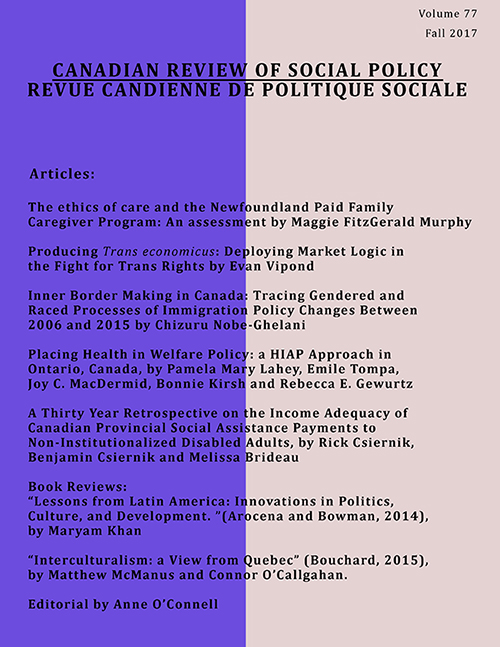Inner border making in Canada: Tracing gendered and raced processes of immigration policy changes between 2006 and 2015
Keywords:
Inner border, Canadian immigration policy, discourse analysis, race and genderAbstract
The Canadian immigration system went through significant changes under the previous Conservative government (2006–2015). This paper examines official narratives in the Citizenship and Immigration Canada (CIC) documents related to two policy changes: 1) Conditional permanent residency for the spousal sponsorship program, and 2) Bill C-43: Faster Removal of Foreign Criminals Act. Drawing on critical race readings of Canadian nation building and critical border literature that re-conceptualizes borders as processes, this paper examines the discursive narratives that enabled bordering processes to shift inward during the previous Conservative government era. My focus on the discursive processes and mechanisms sheds light on linkages between bordering practices and the historical construction of Canada as a white settler nation. I demonstrate the ways in which exclusionary policy developments constructed ‘inner borders’. I argue that the bordering practice at play in these policy changes were only possible through two discursive conditions and functions: 1) the naturalization of the gendered and racialized exclusions built into Canadian national membership, and 2) the erasure of historical and systemic injustice embedded in the Canadian immigration system and Canadian nation-building project as a whole. Through the naturalization and erasure of historical and systemic injustice, “inner borders” became “invisible borders, situated everywhere and nowhere” (Balibar, 2002, p. 78), pushing immigrant women and the racialized community into further precariousness.
Published
How to Cite
Issue
Section
License
1-The author guarantees that the manuscript is an original work not published elsewhere in print or electronically in whole or in part, except in abstract form, that the author has the full power to make this contribution, and that the manuscript contains no matter libelous or otherwise unlawful or which invades the right of privacy or which infringes any proprietary right.
2-The author guarantees that the manuscript has not been previously published in print or electronically and that if the manuscript contains any tables, figures or images fully reproduced or closely adapted from previously published material, the author must obtain the necessary permission from the author/publisher holding the original copyright prior to publication in CRSP. The author may be required to produce evidence of permission granted to CRSP’s editors.
3-As a condition of publication in CRSP, the author assigns all copyright to CRSP, including but not limited to the right to publish, republish, and otherwise distribute this manuscript in print, electronic, or other formats. As CRSP is a non-profit interdisciplinary scholarly journal, the author will receive no royalty or other monetary compensation for the assignment set forth in this agreement.
For the purpose of full disclosure, CRSP will not normally use the content provided by the author in a commercial venture, but for the purpose of disseminating the author’s content to as many readers as possible. For distribution, third parties engaging in commercial activities may be contracted to distribute the content globally, and such parties may make a profit out of the author’s content in their normal course of business. CRSP will not pay the author or reimburse the author in any form based on such commercial activities because the conduct of such commercial activities is outside the control of CRSP.
Any future reference to or use of this published material by the authors must acknowledge CRSP as the original place of publication.
PERMISSION REQUEST/ARCHIVING
Permission is given to author(s) receiving funding via Tri-Council Agencies, the Canadian Institutes of Health Research (CIHR), the Natural Sciences and Engineering Research Council of Canada (NSERC) and the Social Sciences and Humanities Research Council (SSHRC), to make their publications freely available in an Open Access repository within the stated deadline by the Tri-Council Agencies (12 months following publication). Archiving of publication must be a manuscript copy bearing none of the CRSP headers, footers or any other distinguishing marks. No links to the article on the CRSP website is permitted.
Permission requests from third parties to reproduce articles in part or full in academic/educational publications can be directed to the managing editor of CRSP, and will not be unreasonably denied.

